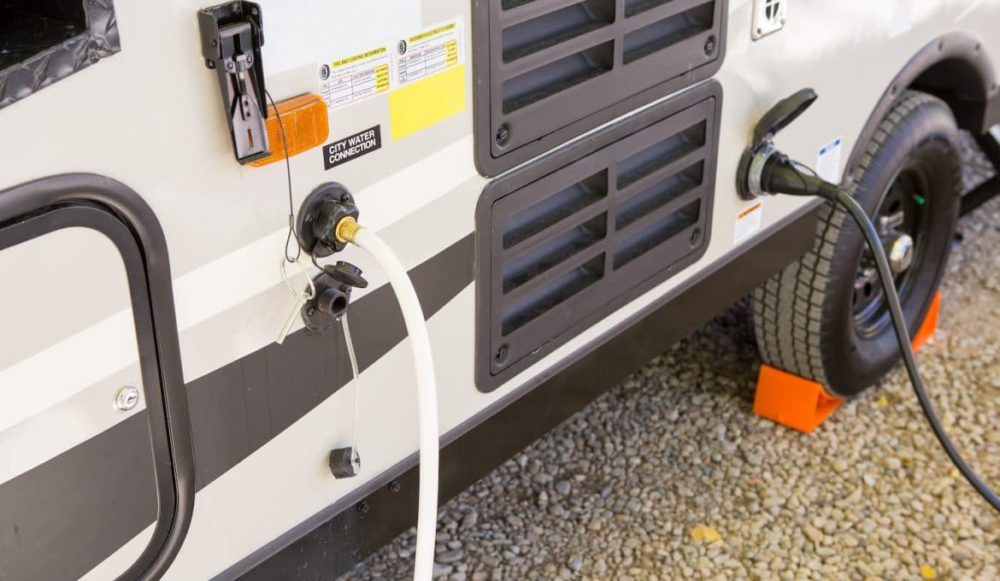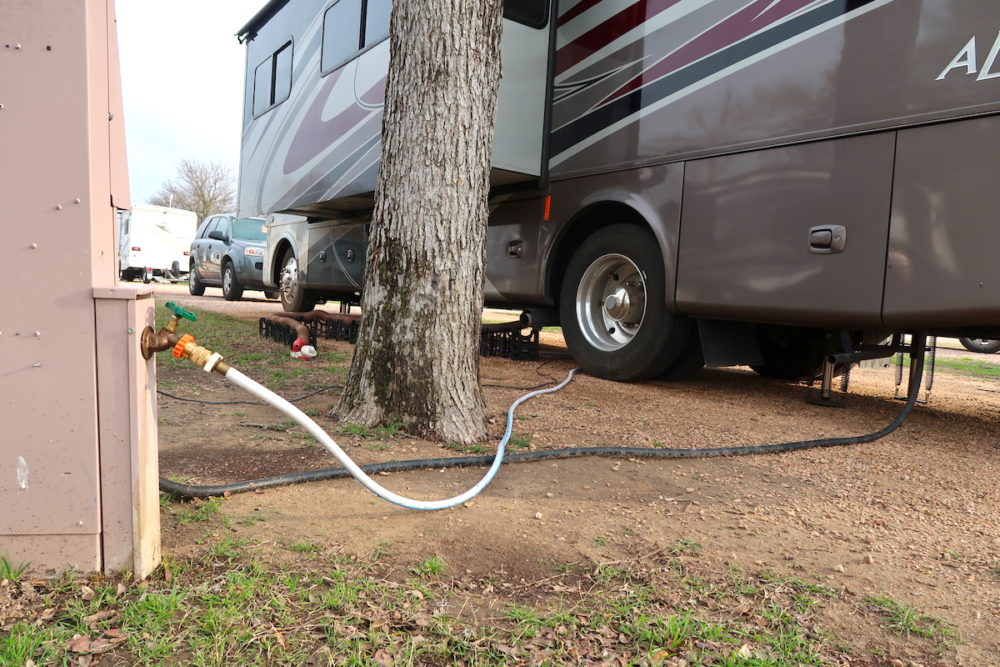How do I Sanitize My RV Water Tank? (Simple DIY Steps)
Before you head off on your summer staycation this season, make sure your water tanks are sanitized – this includes the freshwater system, greywater system, and the entire water system. Cleaning your fresh water system ensures your trip will stay happy and healthy.

Should you sanitize your RV water tank?
Yes! The fresh water tank in your RV is made from plastic and holds drinking and utility water for long periods. If you don’t clean and sanitize your water tank regularly (around every 6 months), it can affect the taste of the water and might lead to the growth of bacteria and mold.
Contents
Why sanitize RV water tank?
Life on the road requires constant attention to the internal workings of your RV to keep it mobile and safe to live in. The RV water system is one of the most frequently used systems in the vehicle and needs to be cleaned regularly. Failing to clean the fresh water tank can lead to health issues and smells.
You should sanitize your fresh water tank for the following reasons:
The water smells unusual
If you encounter a strange smell inside your RV, chances are it’s coming from the water tank. The fresh water tank in an RV is often made from plastic; plastic is light and strong, so it reduces the vehicle’s weight on the road – but causes old water contained inside to smell.
The water tastes bad
If you have old water in your fresh water tank, it will probably taste as bad as it smells. This is something you will notice right away, especially if you drink some water from the tap. It might be less obvious if you boil the water and drink tea instead, so it’s worth testing the RV water system before boiling it.
Lending the RV to someone else
If you decide to take a different kind of vacation this season, you might want to lend your RV to a friend or family member. It’s a generous thing to do, but you don’t want your friends to suffer health issues because of the unsanitized water tank – so you should sanitize your RV water system before lending it out.
You’ve just bought it
Whether the RV you bought is brand new or used, it’s still a good idea to sanitize the fresh water tank right away. In new RVs, the freshwater tank will be clean and ready to fill, but there might be the smell of new plastic. In used RVs, you don’t know when it was last sanitized, so sanitizing it immediately is of utmost importance.
How often should you sanitize RV water tank?
An RV water system should be sanitized at least once a year. Before you head off on your summer road trip, you should take some time to sanitize the RV water system. Sanitize your RV water more often if you take trips more frequently.
Different methods for sanitizing RV water tanks
Of course, the most conventional way to sanitize your RV system is to use a bleach mixture. While this method is quite safe when carried out correctly, some people will be against using bleach, especially since it can be harmful to the environment and water supply. So, here are some alternative methods for sanitization:
Sanitizing RV water tank with vinegar
If you’re serious about saving the planet, consider sanitizing your water system with vinegar. Vinegar is an effective and safe way to sanitize your system; however, you will have to increase the temperature of the solution to 130 degrees – use the RV water heater to achieve this.
Sanitizing RV water tank without bleach
There are some concerns about overconsuming bleach in your RV fresh water system. Alternatives to bleach include white vinegar and baking soda, along with commercial sanitation products.
Sanitizing RV water tank with hydrogen peroxide
Hydrogen peroxide, or chlorine, is used in mains water supplies to decontaminate the fresh water and the system. However, the amounts of chlorine used are carefully measured to avoid any health issues.
Sanitizing RV water tank with concentrated bleach
Concentrated bleach is one of the best ways to kill bacteria and mold in your fresh water tank; although it has some disadvantages, concentrated bleach is fast and effective. To sanitize your RV fresh water tank, leave the concentrated bleach in the tank for at least 8 hours or overnight.
How to Sanitize different RV Water Tanks
If you want to sanitize your RV water tanks, it’s best to use a vinegar solution. Vinegar is used to kill bacteria and mineral build-ups in the pipes of the water pump and water heater – like a kettle. Heat the vinegar in the RV water heater and move it through the system.
How to sanitize RV black water tank
Tools and equipment needed
To effectively sanitize the black tank in your RV, you will need a water supply and some bleach or vinegar. Eco-bleach products are available if you want to protect the local environment.
Step 1
To sanitize your black tank, the first thing you need to do is fill up the freshwater tank. Use the freshwater to fill the black tank; for a 9-gallon tank, you will need around 4 gallons of water.
Step 2
Next, add the bleach (or vinegar) and baking soda mixture to the black tank. For a 9 gallon black tank, you will need a little less than an eighth of a cup of bleach to decontaminate the tank.
Step 3
Once you have added the water and the sanitizing cleaner to the tank, you need to leave it for a time. Park hopping is a good way to slosh the solution around in the tank and make it work.
Step 4
Lastly, empty the black tank of the water and the solution. This can be done by releasing the valve on the bottom of your vehicle in a suitable location.
How to sanitize RV grey water tank
Tools and equipment needed
All you need to sanitize your greywater tank is a supply of fresh water and some bleach or other cleaning agent. The process is simpler than cleaning your black tank and fresh tank.
Step 1
Start by filling your fresh tank with enough water to fill the grey tank and the black tank partially. You will not need to fill the fresh tank to its full capacity.
Step 2
Inside the RV, turn on the tap at the sink and allow the water to run from the fresh tank to the grey tank. Pour a quarter cup of bleach or cleaning solution into the tank with the water.
Step 3
Monitor the water level in the grey tank and stop the water flow when it’s around 20% full. Next, take your RV for a drive and allow the water and bleach solution to slosh around.

How to sanitize RV hot water tank
Tools and equipment needed
Step 1
The first thing you need to do is to turn off the water heater and leave it to cool overnight. This allows you to clean the system without getting scalded by hot water from the system.
Step 2
Turn off the water pump! You will use water that’s already in your RV to clean the water heater, and you don’t want additional water taken into the water heater. Find the pump switch.
Step 3
Find the pressure relief valve on the outside of the vehicle and turn it so that water starts to drain from the system. Next, remove and replace the anode rod that will be used and corroded.
Step 4
Flush the system using a cleaning wand to clean out the old water. Mix a solution of water and vinegar and put it in the tank. Heat the system and let it cool overnight – then drain the mix.
Where can you get RV sanitizing services?
If you don’t have time to sanitize your RV using the steps above, you can procure a sanitizing service from a local car wash or a specialized RV servicing station.
